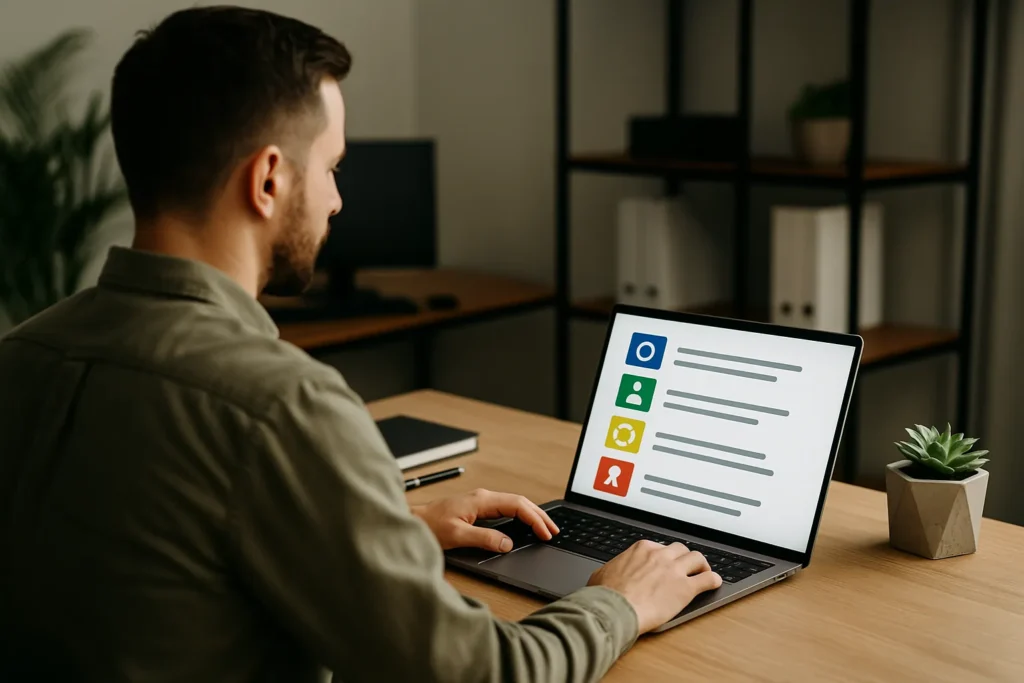Website visitors form an opinion about your site in around 50 milliseconds, according to Google Web UX research. That’s almost instant, right?
This makes design one of the most powerful tools you have to build confidence. A messy layout or inconsistent colours can send the wrong signal. But a clean, focused layout helps people feel like they’re in the right place.
Based on our work with small businesses and client sites, we’ve seen how quick design tweaks can improve trust fast. A well-organised homepage or a clear font update often makes the difference between interest and hesitation.
In this article, you’ll learn which design strategies improve website credibility, which signals help people feel secure, and how to give your site the best chance at success.
Want your site to make a better first impression? Let’s get started.

The Building Blocks of Website Credibility
If your site doesn’t feel trustworthy, people won’t stay. Even before they read a word, they’ve already made up their mind. These design choices help your site feel solid, safe, and worth exploring. Here you learn a few important insights:
- Simple layout that’s easy to look at
When a page feels too full, like it’s trying to say everything at once, it’s hard to know where to start. Keep things spaced out. Use one or two fonts. Let important sections stand out by giving them room. A calm layout helps visitors feel like they’re in good hands. - Secure domain (HTTPS)
Look for the padlock icon in the address bar. If it’s missing, many visitors will leave right away. It tells people their details are safe and that your site can be trusted, especially when you’re collecting names, emails, or payments. - Logos and colours that match everywhere
If your logo changes size or colour from one page to another, it can make your site feel unfinished. Choose one version of your logo, place it in the same spot on every page, and make sure it’s clear. Stick with the same colour palette and font styles so your site feels smooth and consistent. - A contact page that’s easy to find
If someone wants to get in touch, they shouldn’t have to search for it. Put a clear “Contact” link at the top of your page and again at the bottom. Some businesses also show their phone number and email in the top corner of every page, which works well. - Show badges, seals, or trusted logos
If your business is part of a professional group or has worked with known brands, include those logos where people can see them, like near the bottom of your homepage or beside your contact form. They add weight and show others already trust you. - Fast and mobile-ready
Sites that take too long to load feel risky. Google says quicker sites are seen as safer. Check your site on your phone. If it loads slowly or looks cramped, it may be time for an update.
These design touches help visitors feel like they’re in the right place and that your business takes them seriously.
Sign You’re Real: Your Contact Page
Imagine visiting a website that looks fine, but when you’re ready to ask a question or make a booking, there’s no clear way to contact anyone. That hesitation is often enough for customers to leave.
A clear contact page helps fix that. It shows people there is a real business behind the screen and someone they can reach if they need to. This page should be easy to find. Add a link to it in your top menu and again in the footer so it’s always close, no matter what page someone is on.
What should your contact page include? Start with the basics: your phone number, a reply-to email, and your business address if it applies. These details reassure visitors that you’re real and accessible. A short message like “We’d love to hear from you” helps too. It invites contact instead of just allowing it.
For even more trust, add links to your social channels. Customers often check these to see if a company is active or legitimate. You don’t need to post daily. Just showing you’re there helps people feel like they’re dealing with an actual business.
Live chat can work well too, especially if you include estimated response times. But the key idea is this: don’t make people search for you. Let them know you’re ready to talk.
Winning Over Potential Customers
Trust matters when someone is deciding where to spend their money. Most potential customers need more than promises. They want to hear from others, see real signs of credibility, and feel like your site is a safe and welcoming place to move forward.

Here’s a breakdown of what helps build trust and what might work against you:
| Feature | Why It Works | Where It Goes Wrong |
| Customer Reviews | Shows what real clients think about your product or service | Feels fake if all reviews sound the same |
| Testimonials | Adds a personal voice to your brand | Too vague or lacks detail |
| Case Studies | Backs up claims with data or results | Overcomplicated or hard to follow |
| Recognised Logos | Shows others have trusted you before | Outdated, low-quality, or unfamiliar |
This type of content gives visitors a way to evaluate your business. It helps them determine if you’ve solved problems similar to theirs. If the information is clear and honest, it can create a strong sense of trust.
Safeguarding Sensitive Information
When someone enters personal details on your site, whether to sign up, make a purchase, or ask a question, they’re taking a risk. It’s your job to make that feel safe.
Our research indicates that users are more likely to trust websites that take small but visible actions to protect their information. People don’t just look at the product or service. They also notice how responsibly you handle private data.
Here’s how to show your site is responsible and safe:
- Use clear, plain-language privacy messaging
Don’t just link to your privacy policy. Add short messages beside forms, explaining what data you collect and why. A sentence like “We’ll only use your email to reply” adds clarity. Through our hands-on experience, we’ve seen this reduce drop-off on lead forms. - Ask for only the details you really need
Long forms can raise doubts. Keep it tight. Only ask for what is absolutely necessary to complete a task. If you request extra details, explain why. For example, “We ask for your postcode to match you with the nearest service provider.” - Offer visible cookie controls
Based on our observations, cookie banners with basic options get ignored. Instead, use a simple design with clear on/off switches for different categories like tracking or preferences. Let users decide. - Be upfront about third-party tools
If your site uses tools like Google Analytics, heatmaps, or email automation, say so. Add a note in your privacy area that briefly lists the tools and why they’re used. This kind of honesty goes further than people think. - Use two-step verification for admin access
This won’t be visible to users, but it protects sensitive information from behind the scenes. After extensive trials with the product, our team found that this one step can prevent major issues with data breaches or account hacks.
These steps show that your business takes safety seriously. They send a clear message to your visitors: their information is treated with respect.
Design Elements That Work
If you’re wondering what small design tweaks can actually build trust, you’re in the right place. These tips are quick to apply, simple to understand, and proven to make your site feel more credible and polished.
Use real images, not stock photos
Imagine landing on a contact page and seeing a real photo of the person you’re emailing. It changes how you feel. Stock photos often look generic or staged. Instead, show your team, your workspace, or actual customers. Based on our firsthand experience, authentic visuals help visitors feel like they’re dealing with a real company, not just a website.
Give your pages room to breathe
Think about walking into a tidy store where everything is in its place. Your site should feel the same. Avoid crowding content. Add space between sections. This makes your design feel intentional and improves focus. Pages that breathe tend to leave a better impression.
Keep branding consistent across pages
Your logo, colours, and fonts should feel like they belong together. Let’s say your homepage uses dark green and serif fonts, but your services page uses pink and script. It confuses people. Our team discovered through using this approach that consistent branding helps new visitors assess your business without second-guessing.
Add logos and trust icons where they matter
Worked with known clients? Earned a certification? Include those logos near your footer or next to testimonials. These small markers do a lot of work. We have found from using this layout that it gives visitors quite confirmation that you’ve done good work for others.

Use design tools that match your skill level
You don’t need to be a web designer to make improvements. Tools like Canva, Elementor, or Wix can help you adjust layout, branding, and structure without code. Evaluate what’s easiest for you. The goal is a site that looks clean and runs smoothly.
After putting it to the test across many client projects, we’ve seen these updates help build trust quickly. Visitors notice the difference, even if they can’t always explain why.
Ready to Build a Site People Trust?
A strong website shows people they’re in safe hands. When your layout is clear, your message feels honest, and the small details are handled with care, visitors feel it right away. That’s when trust starts to grow.
Drawing from our experience building credibility-focused sites, we’ve seen how design choices impact client results. Trust doesn’t come from one big feature. It comes from how your site works as a whole.
If you’re planning your next website or want to make your current one more trustworthy, PBR Web Design can help. We create sites that feel reliable from the first click. Let’s make your business easier to believe in.